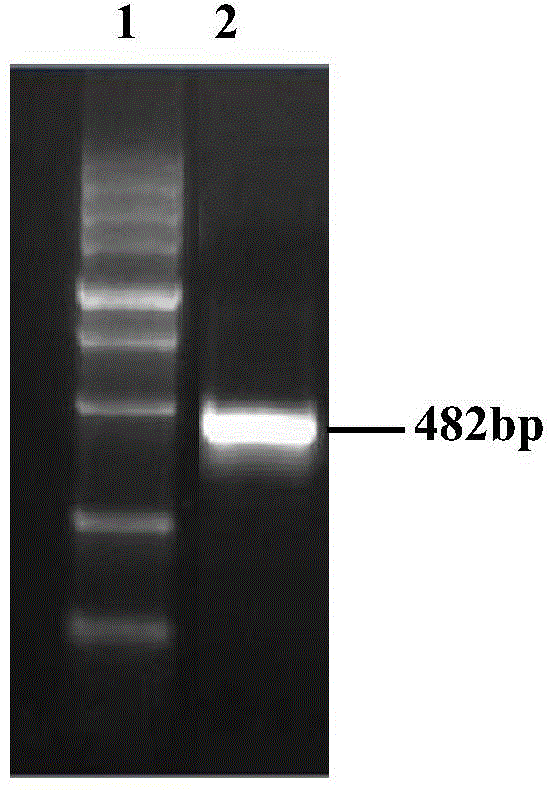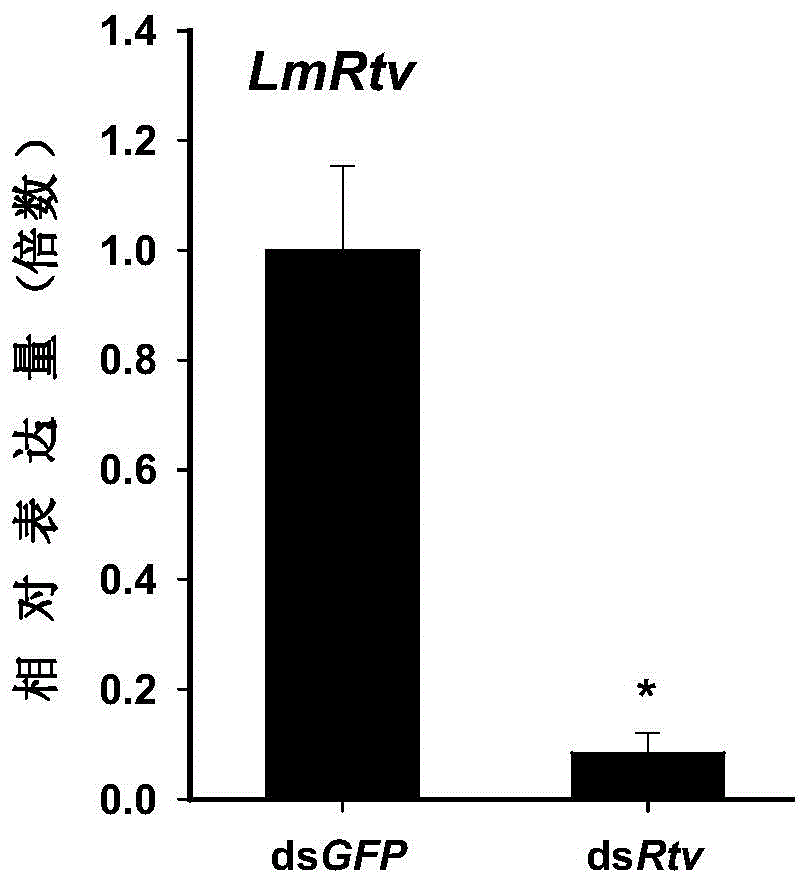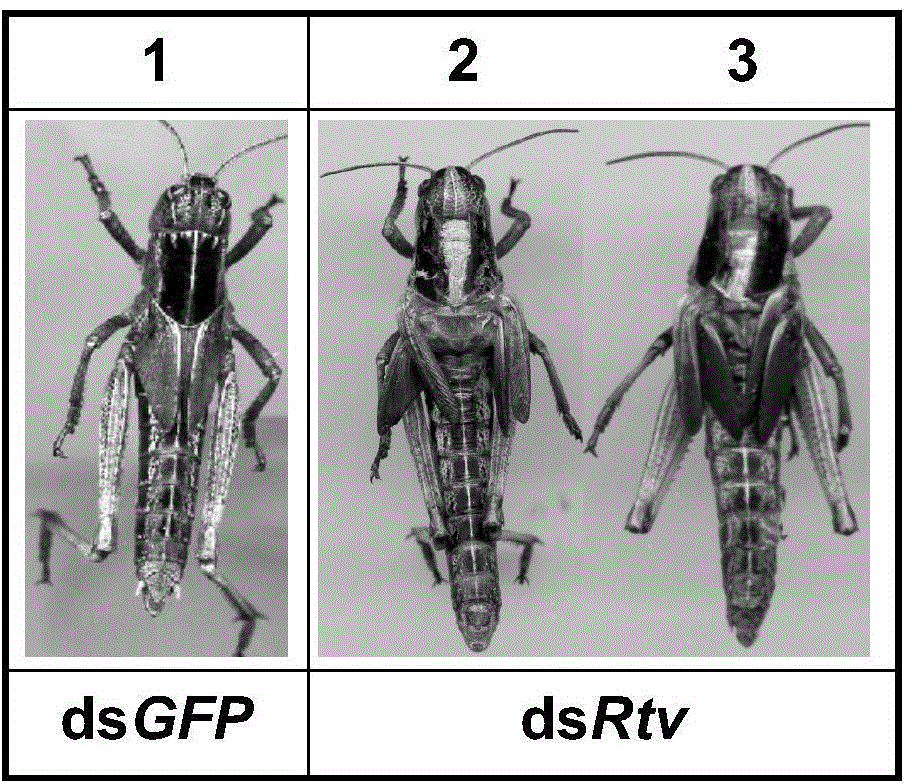Retroactive gene and application of dsRNA (double-stranded ribonucleic acid) of Retroactive gene in pest control
A technology of genes and gene fragments, applied in the biological field, can solve the problems of polluting the agricultural ecological environment, natural enemies and higher animals and other non-target organisms
- Summary
- Abstract
- Description
- Claims
- Application Information
AI Technical Summary
Problems solved by technology
Method used
Image
Examples
Embodiment 1
[0015] Embodiment 1: migratory locust Rtv gene full-length cDNA sequence and encoded amino acid
[0016] 1. Search for Rtv genes of migratory locusts
[0017] The Rtv gene was searched from the transcriptome database of migratory locusts using bioinformatics methods, and the homology analysis was performed using Blastx of the NCBI database, and a full-length sequence of Rtv gene of migratory locusts was confirmed and screened.
[0018] 2. Verification of the full-length cDNA of the migratory locust Rtv gene
[0019] Based on the above-mentioned full-length sequence of the migratory locust Rtv gene, a primer was designed for full-length cloning using primer premier5.0 software. Among them, the upstream primer CGTATGTCACAGTTACCATGAAAATC (SEQ ID NO: 3) and the downstream primer TTATCAGTTCACAAGCCAGTCTCC (SEQ NO: 4). The primers were synthesized by Shanghai Yingwei Jieji Biological Co., Ltd.
[0020] Select 5th-instar migratory locust nymphs with healthy growth and uniform size,...
Embodiment 2
[0023] Embodiment 2: Migratory locust Rtv gene fragment dsRNA synthesis
[0024] 1. Design of dsRNA primers for migratory locust Rtv gene fragment
[0025] Based on the full-length sequence of migratory locust SEQ ID NO: 1, a pair of primers for synthesizing dsRNA were designed using primer premier5.0 software (upstream and downstream primers both contain T7 promoter, shown in italic sequence), wherein the sequence of the upstream primer is The sequence of taatacgactcactatagggGCCAACGGAGCGTATTCTTA (SEQ ID NO: 5) and the downstream primer is taatacgactcactatagggATTCGTTGACGAGTTGCACA (SEQ ID NO: 6). The primers were synthesized by Shanghai Yingwei Jieji Biological Co., Ltd.
[0026] 2. Specific dsRNA synthesis of migratory locust Rtv gene fragment
[0027] The frozen and diluted plasmid in the full-length cDNA verification process of Example 1 was used as a template after thawing and dilution, and PCR amplification was performed with the upstream and downstream primers containin...
Embodiment 3
[0028] Embodiment 3: Lethal experiment of migratory locust Rtv gene fragment dsRNA
[0029] 1. Specific dsRNA Injection
[0030] A total of 34 5th-instar and 2-day-old nymphs with healthy growth, uniform size, and half male and half male were selected. 2.5 μl (6.25 μg) of dsRNA were gently injected into the nymph body cavity using a microsyringe. At the same time, 30 nymphs were injected with the same amount of dsGFP as a control. Both groups of nymphs were reared in a 30°C constant temperature biochemical incubator (light:dark time=14h:10h, temperature 30±2°C, humidity 60%), and supplied with sufficient fresh wheat and wheat bran.
[0031] 2. dsRNA effect detection
[0032] After dsGFP and dsRtv were injected into the locust body cavity for 24 hours, 9 nymphs (3 biological replicates, 3 worms per replicate) were collected to extract RNA according to the TaKaRa Trizol kit, and then reverse transcribed into first-strand cDNA. Real-time PCR was used to detect the mRNA expres...
PUM
| Property | Measurement | Unit |
|---|---|---|
| Relative molecular weight | aaaaa | aaaaa |
Abstract
Description
Claims
Application Information
 Login to View More
Login to View More - R&D
- Intellectual Property
- Life Sciences
- Materials
- Tech Scout
- Unparalleled Data Quality
- Higher Quality Content
- 60% Fewer Hallucinations
Browse by: Latest US Patents, China's latest patents, Technical Efficacy Thesaurus, Application Domain, Technology Topic, Popular Technical Reports.
© 2025 PatSnap. All rights reserved.Legal|Privacy policy|Modern Slavery Act Transparency Statement|Sitemap|About US| Contact US: help@patsnap.com



